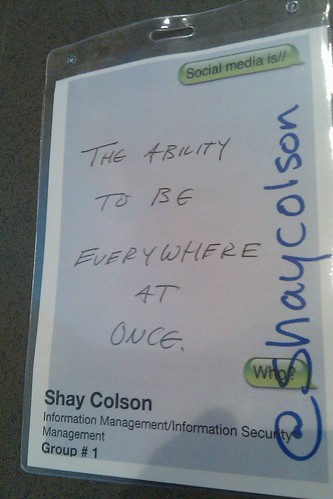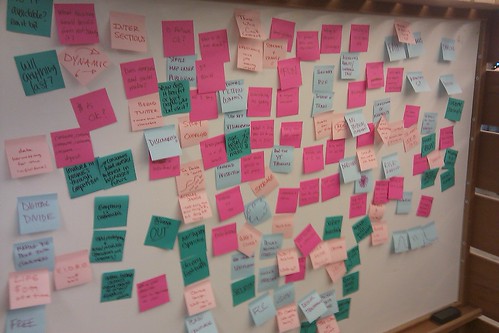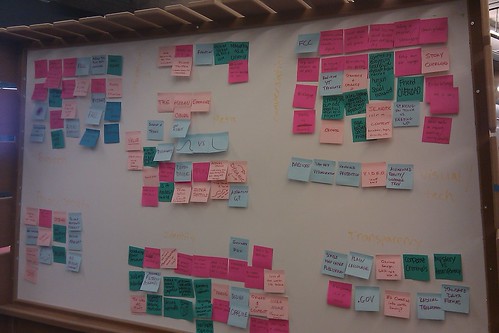Awesome. That’s what.
It’s also how I spent my weekend, after I looked up the definition. 35 other students and I took the leap based on a single invitation email and four little words “Social Media and Business.” What we did over the weekend was absolutely incredible.

Shay’s name tag
Many Thanks
Before we go any further, I’d like to throw a huge shout-out to the people whose hard work made it happen (in no particular order): Liz Liddy, Anthony Rotolo, Chris McCray, Shoham Arad, Jaime Snyder, the Colab crew, and Studio Mercury. These people had the vision, the dedication, and – most importantly – the faith that this event would be a success, which is most definitely was.
Collaboration is Hard
The heart of the weekend was built around collaboration amongst and between other students. Some groups worked great together, while others clearly struggled; this is to be expected: collaboration is hard.
From the moment we arrived, we were paired with our teams. We ate meals together, struggled through the problems together, overcame the challenges together, and ultimately presented our final product together. I was fortunate enough to be on a team that was composed of five contributors, five people who were willing to discuss an issue until we’d resolved it, and five people who were able to take the charrette leap-of-faith together. My hat comes off to Team Toppest Notch.
By far one of the most rewarding things about the weekend was succeeding with a team that I likely wouldn’t have picked for myself. I think it goes to show that there are capable students all across SU’s campus, if only you can harness their capabilities.
How did we do it? Read on…
Process
We spent our first morning sticking with the open-ended theme and put every idea we had about the future of social media onto post-it notes.

We spent hours doing this. We worked until lunch, and ended up with a board of ideas that looked something like this:

After lunch, we spent another set of hours talking about every single idea on every single sticky note and grouping them into common areas: conversation, monetization, transparency, privacy/security, innovation, identity, and meta:

After dinner, we attacked the problem again and built a narrative then evolved into some semblance of the 10 commandments of social media for business. I can’t reproduce them here, but I can tell you that our presentation will be featured on the Colab site soon.
Takeaways
Were we able to define social media in one weekend? No.
Were we able to tell your business exactly what to do to turn followers into dollars? No.
But we did learn that social media exemplifies the human experience, but at an incredibly accelerated and magnified scope and speed. What we’re saying and doing as humans is going farther and faster than it ever has before. Students tackled issues surrounding everything from the underlying core principles to operating in the social media sphere as a business (hint: be authentic) to the ways in which we will teach social media manners to our own children (hint: just like we do or don’t teach them manners now).
For me, personally, the bottom line is that social media is a distinctly human technology. You can use social media to build a following, to build a brand, and to build your business, but at the end of the day there must be something behind your profile. Social media won’t make a bad business better, but it can make a good business great.
What Next?
As I work off the post-charrette hangover, I’ve heard that the charrette model will be continuing in the form of a class offered at Syracuse University Fall semester. I’ve also heard that it will be open to any majors from any programs and that attendance will not be capped.
I would absolutely participate in an event of this format in the future. I found the intensive environment, and concentrated work to be both rewarding and exhausting. This format really allows the energy, curiosity, and unbridled enthusiasm that college students typically carry to be harnessed and channeled into a powerful shared experience that can produce some amazing results.
The applications for these events are infinite. I would to see a few run by companies in place of focus-groups or PR campaigns. For much less money, you can get more ideas, more content, more creativity, and better PR. All it takes is a little faith in the process, food and caffeine, and that magical, intangible, unpredictable experience known as collaboration.
